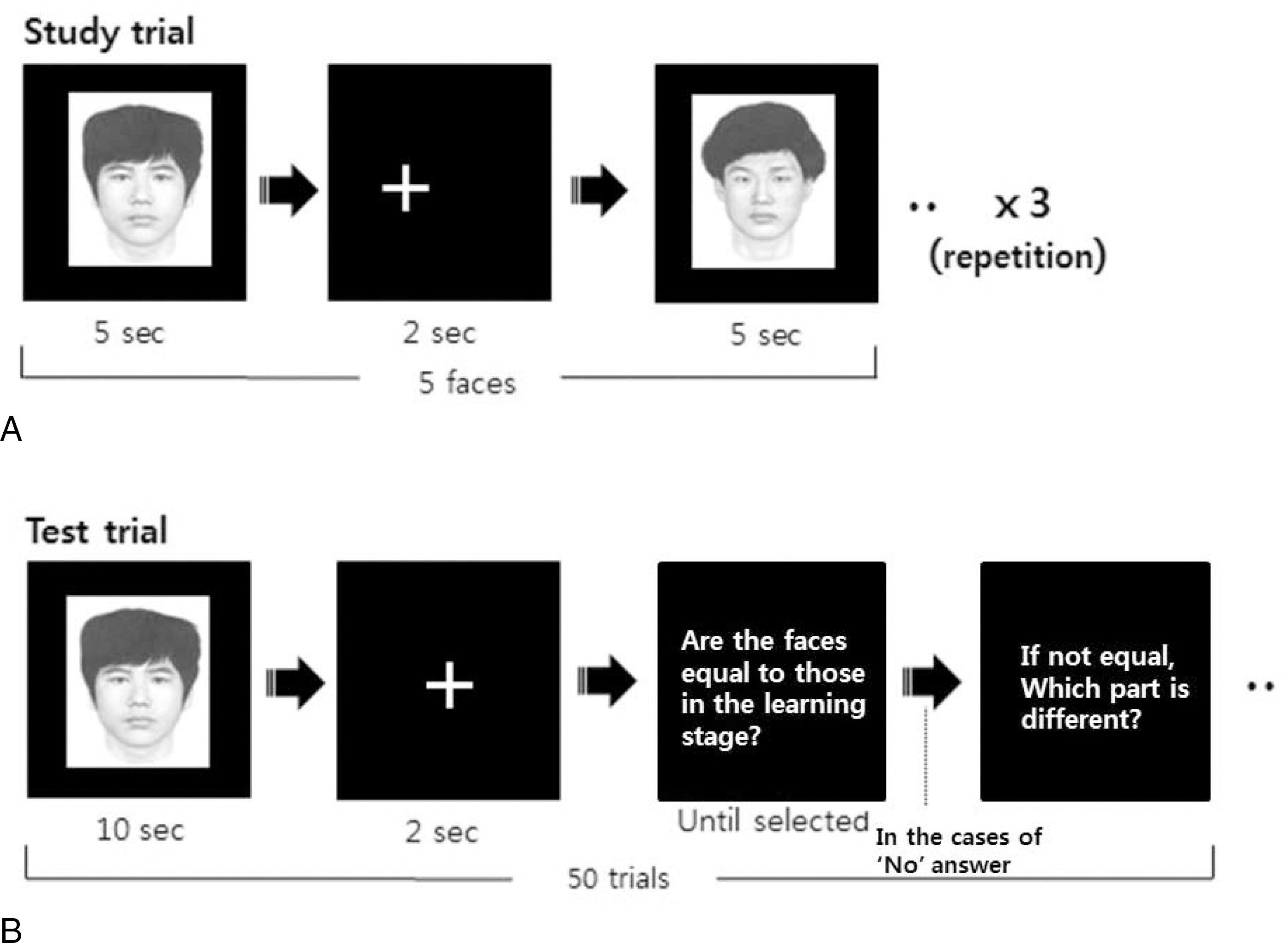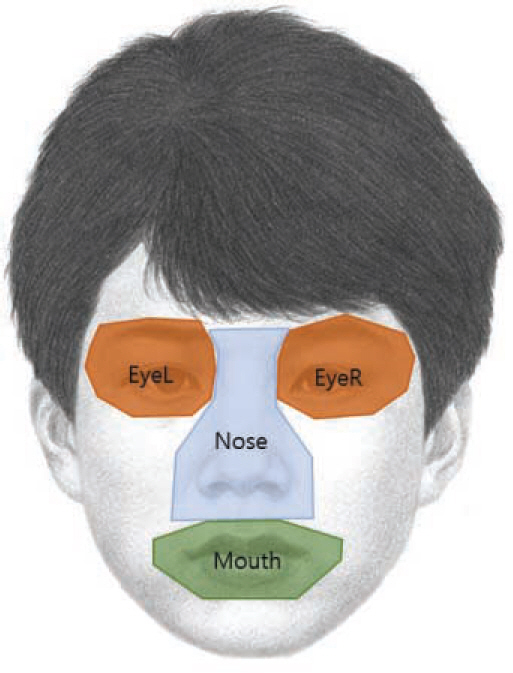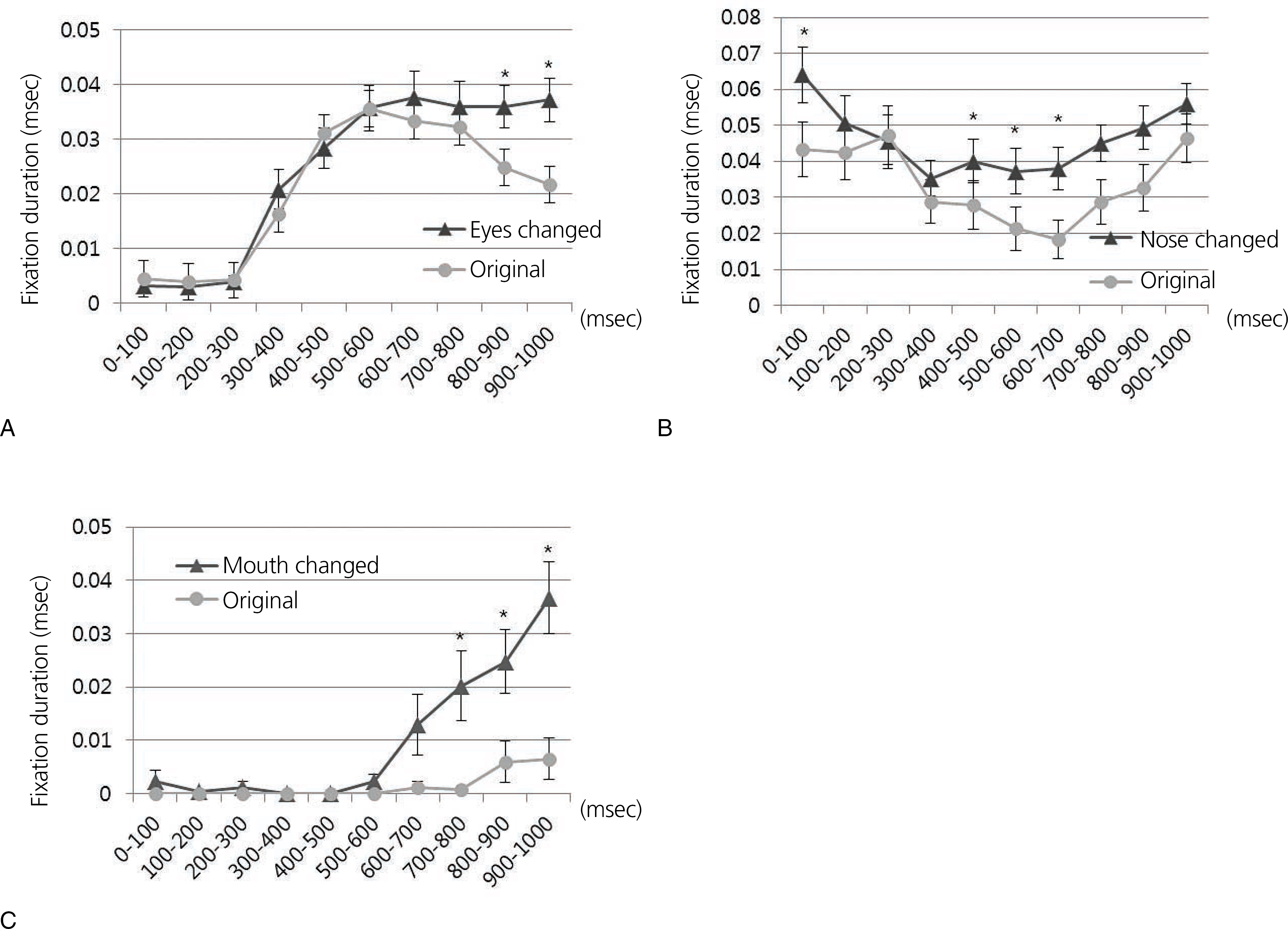Korean J Leg Med.
2015 Nov;39(4):120-126. 10.7580/kjlm.2015.39.4.120.
Effects of Eye Movements on Recognition in a Manipulated-Face Memory Task
- Affiliations
-
- 1Psychological Forensics Division, National Forensic Service, Wonju, Korea. ksham@korea.kr
- 2Institute of Forensic Medicine and Department of Forensic Medicine, Seoul National University College of Medicine, Seoul, Korea. yoosh@snu.ac.kr
- KMID: 2130856
- DOI: http://doi.org/10.7580/kjlm.2015.39.4.120
Abstract
- We evaluated the effects of eye movements on facial feature recognition and memory retrieval. Thirty-eight participants learned the faces of five men, including features of the faces (eyes, nose, and mouth), and then performed a recognition memory task for partially manipulated versions of the faces. Bilateral eye movements, recognition accuracy, and mean fixation duration were evaluated. We observed differences in fixation durations for the manipulated features of the faces (eyes, F(3,78)=11.95, P<0.001; and mouth, F(3,78)=21.38, P<0.001). These findings demonstrate that eye movements have a functional role in learning and recognizing human faces. Furthermore, fixation durations increased for the manipulated facial features, suggesting that eye movements during recognition are not simply patterns produced during learning.
Keyword
- Memory; Eye; Movement; Face; Recognition
Figure
Reference
-
1. Schurgin MW, Nelson J, Iida S, et al. Eye movements during emotion recognition in faces. J Vis. 2014; 14:14.
Article2. Perrett D, Emery NJ. Understanding the intentions of others from visual signals: neuropsychological evidence. Cah Psychol Cogn. 1994; 13:683–94.3. Rensink RA, O’ Regan JK, Clark JJ. To see or not to see: the need for attention to perceive changes in scenes. Psychol Sci. 1997; 8:368–73.
Article4. Gobel MS, Kim HS, Richardson DC. The dual function of social gaze. Cognition. 2015; 136:359–64.
Article5. Chua HF, Boland JE, Nisbett RE. Cultural variation in eye movements during scene perception. Proc Natl Acad Sci U S A. 2005; 102:12629–33.6. Bird GD, Lauwereyns J, Crawford MT. The role of eye movements in decision making and the prospect of exposure effects. Vision Res. 2012; 60:16–21.
Article7. Parnamets P, Johansson P, Hall L, et al. Biasing moral decisions by exploiting the dynamics of eye gaze. Proc Natl Acad Sci U S A. 2015; 112:4170–5.8. Johansson R, Holsanova J, Dewhurst R, et al. Eye movements during scene recollection have a functional role, but they are not reinstatements of those produced during encoding. J Exp Psychol Hum Percept Perform. 2012; 38:1289–314.
Article9. Hannula DE, Baym CL, Warren DE, et al. The eyes know: eye movements as a veridical index of memory. Psychol Sci. 2012; 23:278–87.10. Hannula DE, Althoff RR, Warren DE, et al. Worth a glance: using eye movements to investigate the cognitive neuroscience of memory. Front Hum Neurosci. 2010; 4:166.
Article11. Henderson JM. Human gaze control during real-world scene perception. Trends Cogn Sci. 2003; 7:498–504.
Article12. Ryan JD, Althoff RR, Whitlow S, et al. Amnesia is a deficit in relational memory. Psychol Sci. 2000; 11:454–61.
Article13. Callan MJ, Ferguson HJ, Bindemann M. Eye movements to audiovisual scenes reveal expectations of a just world. J Exp Psychol Gen. 2013; 142:34–40.
Article14. Althoff RR, Cohen NJ. Eye-movement-based memory effect: a reprocessing effect in face perception. J Exp Psychol Learn Mem Cogn. 1999; 25:997–1010.
Article15. van Belle G, Ramon M, Lefevre P, et al. Fixation patterns during recognition of personally familiar and unfamiliar faces. Front Psychol. 2010; 1:20.
Article16. Taubert J, Apthorp D, Aagten-Murphy D, et al. The role of holistic processing in face perception: evidence from the face inversion effect. Vision Res. 2011; 51:1273–8.
Article17. Tanaka JW, Sengco JA. Features and their configuration in face recognition. Mem Cognit. 1997; 25:583–92.
Article18. Chelnokova O, Laeng B. Three-dimensional information in face recognition: an eye-tracking study. J Vis. 2011; 11:27.
Article19. Hosie JA, Ellis HD, Haig ND. The effect of feature displacement on the perception of well-known faces. Perception. 1988; 17:461–74.
Article20. Zhao W, Chellappa R, Phillips PJ, et al. Face recognition: a literature survey. ACM Comput Surv. 2003; 35:399–458.21. Sung YS, Cho K, Kim DY, et al. Difference in visual attention during the assessment of facial attractiveness and truthworthiness. Korean J Sci Emot Sensib. 2010; 13:533–40.22. Heisz JJ, Shore DI. More efficient scanning for familiar faces. J Vis. 2008; 8:9. .1-10.
Article23. Bindemann M, Scheepers C, Burton AM. Viewpoint and center of gravity affect eye movements to human faces. J Vis. 2009; 9:7. .1-16.
Article24. Hsiao JH, Cottrell G. Two fixations suffice in face recognition. Psychol Sci. 2008; 19:998–1006.
Article
- Full Text Links
- Actions
-
Cited
- CITED
-
- Close
- Share
- Similar articles
-
- The Effect of Bilateral Eye Movements on Emotional Face Recognition Memory Task
- The Effect of Bilateral Eye Movements on Face Recognition in Patients with Schizophrenia
- Effects of a Memory Training Program Using Efficacy Sources on Memory Improvement in Elderly People
- The Effects of the Older Adults' Depression on Metamemory and Memory Performance
- The Influence of Bilateral Eye Movement on Recognition Memory Task Performance





